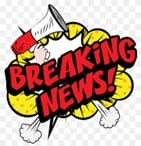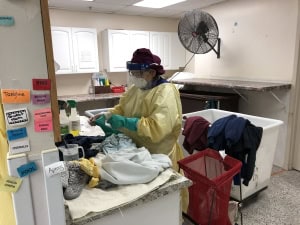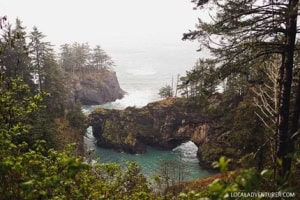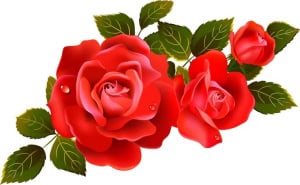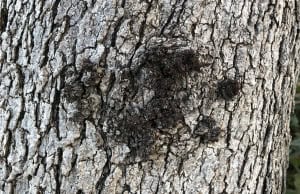By George Yates and Arti
Forward
You may have noticed some media coverage of ChatGPT, so we thought to have a bit of fun this month with this article which is an example of how ChatGPT can aid in journalism.
Thus, we are introducing Arti as new member to The Complement’s writing staff. Read the accompanying article, The Complement Embraces Artificial Intelligence, for some information on Artificial Intelligence and ChatGPT.
Content generated by Arti is identified by using Bold Italic (The quick red fox jumped over the lazy brown dog.) and the Arial font is used for your (hopefully) sentient coauthor.
Bandon Oregon Travelog
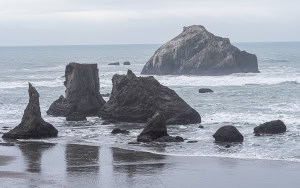
View from our balcony at the Sunset Motel
Fran and I recently took a four-day getaway to Bandon, OR to indulge our photography hobby. We stayed at the Sunset motel and had a magnificent ocean view.

Sunset Motel viewed from Coquille Point
Bandon is a great choice as a vacation home base. The town itself has much to offer and driving about one-half hour north or south gets you to some of the best the Oregon coast has to offer.
The Oregon Coast near Bandon is a picturesque stretch of rugged coastline that offers scenic views, diverse wildlife, and plenty of recreational activities for visitors.
Its unique geology and stunning scenery have made it a popular destination for tourists and photographers alike. The coast of Bandon is renowned for its dramatic cliffs, rocky shores, and diverse coastal formations, which are the result of thousands of years of wind and wave erosion.
In addition to its geological formations, the coast of Bandon is also home to an abundance of wildlife. The area is a popular destination for bird watching, and visitors can see a variety of species, including pelicans, seagulls, and terns. The rocky shorelines and cliffs are also home to a diverse array of sea life, including starfish, sea anemones, and mussels.
One of the most iconic coastal formations in Bandon is Face Rock. This massive rock formation is located on the south side of the town and stands over 150 feet tall. It is believed to be a remnant of an ancient sea cave that has been carved away by the relentless waves of the Pacific Ocean. The striking, almost human-like face that has been carved into the rock by the elements has given Face Rock its name. Visitors can take a walk along the beach and admire the formation from different angles, taking in the full beauty of its intricate details.

Face Rock
There is an American Indian legend about this spot. Some say they hear a maiden’s voice on the wind, and standing on the cliff overlooking the ocean you can easily pick out the face on Face Rock. There is a well-kept trail to the beach, and several rocky intertidal areas to explore at low tide.
Bandon is also known for its sea stacks, which are large rocks that have been separated from the mainland by years of erosion. The most famous of these is the Needles, located just south of the town. The Needles are a collection of tall, thin rock formations that rise out of the ocean, offering a breathtaking view of the surrounding landscape.

The Needles
The coast of Bandon is also home to a number of sea arches, which are formed when waves have eroded the base of a rock formation, leaving a large archway. The most famous of these is Arch Rock, located on the north side of the town. Arch Rock is a massive, natural stone arch that spans over 30 feet in width, making it one of the largest arches in the Pacific Northwest. Visitors can walk along a trail that runs alongside the rock and admire its beauty from a safe distance.
Coquille Point, a popular spot for wildlife viewing. This location is known for its large colonies of seals and sea lions, and visitors can often see them basking in the sun on the rocks or swimming in the water below. Other wildlife that can be spotted here include sea otters, harbor porpoises, and a variety of bird species.

Coquille Point Arch Rock
Bandon is also home to a number of charming and historic buildings. Many of the buildings in the town date back to the early 20th century, and they have been well-preserved over the years. One of the most historic buildings in Bandon is the Face Rock Creamery, which was built in the early 1900s. This creamery is famous for its delicious cheese, and it is a must-visit for anyone who loves cheese.
Bandon’s Historic District, also known as Old Town, is located along the Coquille River and has many restaurants and tourist shops. Bandon Sweets & Treats has a good selection of chocolates. The Second Street Gallery art gallery offers a selection of local art and Foley’s Irish Pub (draft Guinness, the Shepard’s pie is average) is a fun place.
While touring the Historic District, we spotted an area of old pilings and thought they would make for an interesting photo composition. Better than the pilings, we spotted a Great Blue Heron hunting for a morning meal.

Great Blue Heron spotted near the Bandon Historic District
Another historic building in Bandon is the Bandon Lighthouse. This lighthouse was built in the late 1800s, and it is still in operation today. The lighthouse is a beautiful structure that is surrounded by lush green forests and rolling hills, and it offers breathtaking views of the coastline.
One can photograph the lighthouse from many viewpoints. I liked this composition from across the Coquille River which provides an interesting foreground.
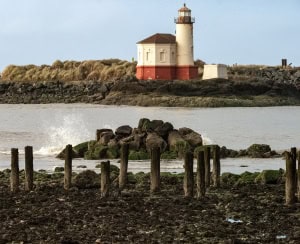
Coquille Point Lighthouse
The Oregon coast is known for its magnificent sunsets. Unfortunately, we only had one good sunset.
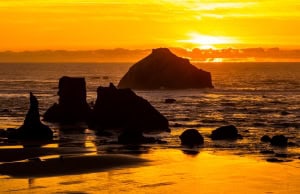
Sunset from our hotel room
As mentioned, Bandon is a great location for taking day trips to the north and to the south.
About a 40 minute drive north of Bandon is the historic fishing town of Charleston which is located at the mouth of the Coos River. This charming town is home to a thriving fishing fleet, and visitors can watch the boats coming and going, or try their hand at fishing from the nearby pier.
Charleston is home to several seafood restaurants and is a great place to try fresh local cuisine. Charleston also has a beautiful harbor, which is a great place to watch the boats come and go.
Well that is what Arti had to say about Charleston, unfortunately for us we arrived at the wrong time of day. The harbor was peaceful, with little activity. The sky was cloudless with the sun near zenith. Not ideal for photography. We quickly decided to move on toward Shore Acres State Park.
Just a short drive from Charleston is the Shore Acres State Park, which offers breathtaking views of the Pacific Ocean and the surrounding coastline. The park features a botanical garden with a diverse collection of plants, as well as scenic trails that offer views of the ocean, wildlife, and the surrounding forests.
We never made it to Shore Acres, en route we came across a pull out named Sunset Bay Middle, part of the Ocean Shore Recreation Area. This was an unplanned stop and it turned out to be one of the best for its wave action.

Waves breaking at Sunset Bay – 1

Waves breaking at Sunset Bay – 2
We had on and off rain showers and were lucky to capture a rainbow.
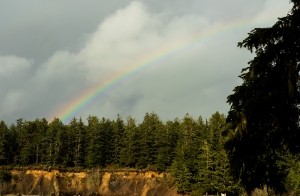
Rainbow at Sunset Bay
Continuing south on Hwy 540, the Cape Argo Hwy, you come to the Simpson Reef Overlook and Cape Argo State Park.
Simpson Reef is home to many seals.

The very noisy seals at Simpson Reef
We returned to our motel to prepare for the next day’s travels.
Driving south of Bandon for about one half an hour we proceeded to Cape Blanco State Park. This park is one of the most beautiful and remote areas of the Oregon coast. The park offers incredible views of the coast, beautiful beaches, and a variety of hiking trails that lead through the surrounding wilderness. The park is also home to several historic sites, including the Cape Blanco Lighthouse, which is one of the oldest lighthouses in Oregon, and the Hughes Historic House.

Cape Blanco Lighthouse framed by its welcome sign


Cape Blanco shoreline
On the leisurely drive home to RVM we took a short detour to the Abacela Vineyard. We have enjoyed their wines since moving to RVM and decided to indulge in a noontime wine tasting. Their Charcuterie board was excellent, however we did supply our own chocolate from Bandon Sweets & Treats.
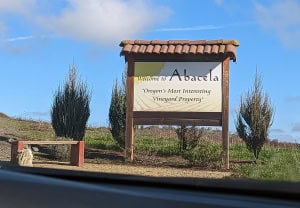
Welcome to Abacela
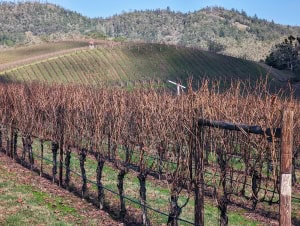
In conclusion, the Oregon Coast near Bandon is a must-visit destination for anyone looking for a unique and unforgettable outdoor experience. From stunning views, diverse wildlife, and a range of recreational activities, this region offers something for everyone.
The coastal formations of Bandon are truly awe-inspiring. From the striking Face Rock to the majestic Needles, the town is home to some of the most unique and beautiful geological formations in the Pacific Northwest. Whether you’re an amateur photographer, a nature lover, or just looking for a new adventure, the Oregon Coast is an ideal destination that you won’t soon forget.
